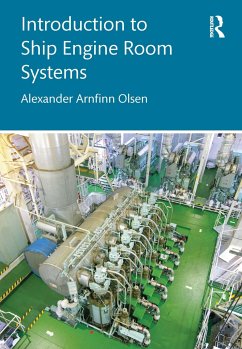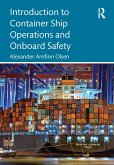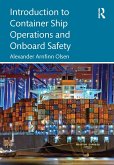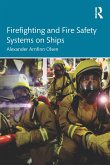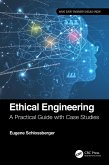Alexander Arnfinn Olsen (UK RINA Consulting Defence)
Introduction to Ship Engine Room Systems
Alexander Arnfinn Olsen (UK RINA Consulting Defence)
Introduction to Ship Engine Room Systems
- Broschiertes Buch
- Merkliste
- Auf die Merkliste
- Bewerten Bewerten
- Teilen
- Produkt teilen
- Produkterinnerung
- Produkterinnerung
This outlines the key systems, machinery and equipment found in a shipâ s engine room, from their function to operation and maintenance. It is an introduction for marine engineering HNC, HND and foundation degree students and cadets, and a useful guide for deck officers and cadets.
Andere Kunden interessierten sich auch für
![Introduction to Container Ship Operations and Onboard Safety Introduction to Container Ship Operations and Onboard Safety]() Alexander Arnfinn OlsenIntroduction to Container Ship Operations and Onboard Safety49,99 €
Alexander Arnfinn OlsenIntroduction to Container Ship Operations and Onboard Safety49,99 €![Introduction to Container Ship Operations and Onboard Safety Introduction to Container Ship Operations and Onboard Safety]() Alexander Arnfinn OlsenIntroduction to Container Ship Operations and Onboard Safety90,99 €
Alexander Arnfinn OlsenIntroduction to Container Ship Operations and Onboard Safety90,99 €![Advanced Concepts and Technologies for Electric Vehicles Advanced Concepts and Technologies for Electric Vehicles]() Advanced Concepts and Technologies for Electric Vehicles163,99 €
Advanced Concepts and Technologies for Electric Vehicles163,99 €![Autonomous Ships and the Law Autonomous Ships and the Law]() Autonomous Ships and the Law40,99 €
Autonomous Ships and the Law40,99 €![Firefighting and Fire Safety Systems on Ships Firefighting and Fire Safety Systems on Ships]() Alexander Arnfinn Olsen (UK RINA Consulting Defence)Firefighting and Fire Safety Systems on Ships68,99 €
Alexander Arnfinn Olsen (UK RINA Consulting Defence)Firefighting and Fire Safety Systems on Ships68,99 €![Ethical Engineering Ethical Engineering]() Eugene SchlossbergerEthical Engineering53,99 €
Eugene SchlossbergerEthical Engineering53,99 €![Machine Learning and the Internet of Things in Solar Power Generation Machine Learning and the Internet of Things in Solar Power Generation]() Machine Learning and the Internet of Things in Solar Power Generation136,99 €
Machine Learning and the Internet of Things in Solar Power Generation136,99 €-
-
-
This outlines the key systems, machinery and equipment found in a shipâ s engine room, from their function to operation and maintenance. It is an introduction for marine engineering HNC, HND and foundation degree students and cadets, and a useful guide for deck officers and cadets.
Hinweis: Dieser Artikel kann nur an eine deutsche Lieferadresse ausgeliefert werden.
Hinweis: Dieser Artikel kann nur an eine deutsche Lieferadresse ausgeliefert werden.
Produktdetails
- Produktdetails
- Verlag: Taylor & Francis Ltd
- Seitenzahl: 426
- Erscheinungstermin: 6. April 2023
- Englisch
- Abmessung: 246mm x 174mm x 23mm
- Gewicht: 742g
- ISBN-13: 9781032342276
- ISBN-10: 1032342277
- Artikelnr.: 66266843
- Herstellerkennzeichnung
- Libri GmbH
- Europaallee 1
- 36244 Bad Hersfeld
- gpsr@libri.de
- Verlag: Taylor & Francis Ltd
- Seitenzahl: 426
- Erscheinungstermin: 6. April 2023
- Englisch
- Abmessung: 246mm x 174mm x 23mm
- Gewicht: 742g
- ISBN-13: 9781032342276
- ISBN-10: 1032342277
- Artikelnr.: 66266843
- Herstellerkennzeichnung
- Libri GmbH
- Europaallee 1
- 36244 Bad Hersfeld
- gpsr@libri.de
Alexander Olsen is a Senior Consultant at RINA Consulting Defence UK. He is STCW II 1995 qualified and has also worked as a marine training designer, marine auditor, and fisheries observer. He is the author of Introduction to Ship Operations and Onboard Safety and Core Concepts of Maritime Navigation (both with Routledge, 2022).
Part I. Steering and Propulsion Systems. 1. Rudder and Steering Gear. 2.
Propeller Design and Function. 3. Introduction to the Main Engine. 4. Key
Components of the Main Engine. 5. Main Engine Pre-Start Checks and
Monitoring. 6. Slow Steaming and Economic Fuel Consumption. 7. Exhaust Gas
System and Scrubbers. 8. Engine Room Lubrication Systems. 9. Essential
Engine Room Machinery Maintenance and Troubleshooting. 10. Mechanical
Measuring Tools and Gauges. Part II. Power Generation. 11. Marine Diesel
Generators. 12. Marine Electrical Systems. 13. Electrical Distribution
Systems and Redundancy. 14. Air Compressor. Part III. Heating, Ventilation
and Air Conditioning. 15. Marine Boiler. 16. Central Cooling System. 17.
Refrigeration and Air Conditioning. Part IV. Water Management Systems. 18.
Ballast Water Management. 19. Oily Water Separator. 20. Wastewater
Management. 21. Freshwater Generation. 22. Pipes, Tubes, Bends and Valves.
Part V. Engine Room Tanks and Bunkering Operations. 23. Main Fuel, Diesel
and Lube Oil Tanks on Ships. 24. Bunkering Operations. Part VI. Engine Room
Fires and Emergency Response. 25. General Emergency Drills, Alarms and
Emergency Systems. 26. Engine Room Explosions and Fires. 27. Engine Room
Drills, Firefighting Procedures and Apparatus. 28. Engine Room Flooding.
Part VII. Engine Room Watch Procedures. 29. Engine Room Watch Procedures.
30. Engine Room Logbook Entries and Checklists. Appendix. Recommended
Reading for Marine Engineers.
Propeller Design and Function. 3. Introduction to the Main Engine. 4. Key
Components of the Main Engine. 5. Main Engine Pre-Start Checks and
Monitoring. 6. Slow Steaming and Economic Fuel Consumption. 7. Exhaust Gas
System and Scrubbers. 8. Engine Room Lubrication Systems. 9. Essential
Engine Room Machinery Maintenance and Troubleshooting. 10. Mechanical
Measuring Tools and Gauges. Part II. Power Generation. 11. Marine Diesel
Generators. 12. Marine Electrical Systems. 13. Electrical Distribution
Systems and Redundancy. 14. Air Compressor. Part III. Heating, Ventilation
and Air Conditioning. 15. Marine Boiler. 16. Central Cooling System. 17.
Refrigeration and Air Conditioning. Part IV. Water Management Systems. 18.
Ballast Water Management. 19. Oily Water Separator. 20. Wastewater
Management. 21. Freshwater Generation. 22. Pipes, Tubes, Bends and Valves.
Part V. Engine Room Tanks and Bunkering Operations. 23. Main Fuel, Diesel
and Lube Oil Tanks on Ships. 24. Bunkering Operations. Part VI. Engine Room
Fires and Emergency Response. 25. General Emergency Drills, Alarms and
Emergency Systems. 26. Engine Room Explosions and Fires. 27. Engine Room
Drills, Firefighting Procedures and Apparatus. 28. Engine Room Flooding.
Part VII. Engine Room Watch Procedures. 29. Engine Room Watch Procedures.
30. Engine Room Logbook Entries and Checklists. Appendix. Recommended
Reading for Marine Engineers.
Part I. Steering and Propulsion Systems. 1. Rudder and Steering Gear. 2.
Propeller Design and Function. 3. Introduction to the Main Engine. 4. Key
Components of the Main Engine. 5. Main Engine Pre-Start Checks and
Monitoring. 6. Slow Steaming and Economic Fuel Consumption. 7. Exhaust Gas
System and Scrubbers. 8. Engine Room Lubrication Systems. 9. Essential
Engine Room Machinery Maintenance and Troubleshooting. 10. Mechanical
Measuring Tools and Gauges. Part II. Power Generation. 11. Marine Diesel
Generators. 12. Marine Electrical Systems. 13. Electrical Distribution
Systems and Redundancy. 14. Air Compressor. Part III. Heating, Ventilation
and Air Conditioning. 15. Marine Boiler. 16. Central Cooling System. 17.
Refrigeration and Air Conditioning. Part IV. Water Management Systems. 18.
Ballast Water Management. 19. Oily Water Separator. 20. Wastewater
Management. 21. Freshwater Generation. 22. Pipes, Tubes, Bends and Valves.
Part V. Engine Room Tanks and Bunkering Operations. 23. Main Fuel, Diesel
and Lube Oil Tanks on Ships. 24. Bunkering Operations. Part VI. Engine Room
Fires and Emergency Response. 25. General Emergency Drills, Alarms and
Emergency Systems. 26. Engine Room Explosions and Fires. 27. Engine Room
Drills, Firefighting Procedures and Apparatus. 28. Engine Room Flooding.
Part VII. Engine Room Watch Procedures. 29. Engine Room Watch Procedures.
30. Engine Room Logbook Entries and Checklists. Appendix. Recommended
Reading for Marine Engineers.
Propeller Design and Function. 3. Introduction to the Main Engine. 4. Key
Components of the Main Engine. 5. Main Engine Pre-Start Checks and
Monitoring. 6. Slow Steaming and Economic Fuel Consumption. 7. Exhaust Gas
System and Scrubbers. 8. Engine Room Lubrication Systems. 9. Essential
Engine Room Machinery Maintenance and Troubleshooting. 10. Mechanical
Measuring Tools and Gauges. Part II. Power Generation. 11. Marine Diesel
Generators. 12. Marine Electrical Systems. 13. Electrical Distribution
Systems and Redundancy. 14. Air Compressor. Part III. Heating, Ventilation
and Air Conditioning. 15. Marine Boiler. 16. Central Cooling System. 17.
Refrigeration and Air Conditioning. Part IV. Water Management Systems. 18.
Ballast Water Management. 19. Oily Water Separator. 20. Wastewater
Management. 21. Freshwater Generation. 22. Pipes, Tubes, Bends and Valves.
Part V. Engine Room Tanks and Bunkering Operations. 23. Main Fuel, Diesel
and Lube Oil Tanks on Ships. 24. Bunkering Operations. Part VI. Engine Room
Fires and Emergency Response. 25. General Emergency Drills, Alarms and
Emergency Systems. 26. Engine Room Explosions and Fires. 27. Engine Room
Drills, Firefighting Procedures and Apparatus. 28. Engine Room Flooding.
Part VII. Engine Room Watch Procedures. 29. Engine Room Watch Procedures.
30. Engine Room Logbook Entries and Checklists. Appendix. Recommended
Reading for Marine Engineers.

